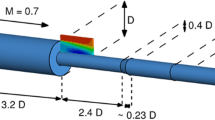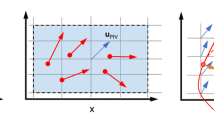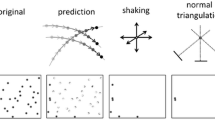Abstract
Emerging time-resolved volumetric PIV techniques have made simultaneous measurements of velocity and pressure fields possible. Yet, in many experimental setups, satisfying the spatial and temporal resolution requirements is a challenge. To improve the quality of sparse and noisy data, this paper introduces a constrained cost minimization (CCM) technique, which interpolates unstructured particle tracks to obtain the velocity, velocity gradients, material acceleration, hence the pressure, on a Eulerian grid. This technique incorporates physical constraints, such as a divergence-free velocity field and curl-free pressure gradients. The performance is evaluated using synthetic particle tracks for an unsteady double gyre and direct numerical simulations data for a turbulent channel flow, with varying particle concentrations and added errors. The errors in pressure, calculated using omni-directional integration, and correlations with the original data are compared to those obtained using the singular value decomposition (SVD) interpolation technique. The CCM errors are mostly lower, and the correlation is higher and less sensitive to particle sparsity and added errors compared to those of SVD. The synthetic particle traces are also projected onto four planar images to evaluate the performance of the new procedure together with shake-the-box (STB) particle tracking. A comparison of pressure spectra and correlation with the original data show very good agreement for the CCM method. Hence, CCM appears to be an effective method for improving the interpolation of sparse data. Sample experimental data obtained in the shear layer behind a backward-facing step demonstrate the application of STB and CCM to resolve the pressure field in coherent vortex structures.
Graphic abstract











Similar content being viewed by others
References
Agarwal K, Ram O, Katz J (2018) Cavitating structures at inception in turbulent shear flow. CAV18. https://doi.org/10.1115/1.861851_ch33
Agarwal K, Ram O, Wang J, Katz J (2019) Velocity and pressure reconstruction from sparse particle fields. ISPIV 2019
Aitken AC (1935) On least squares and linear combinations of observations. Proc R Soc Edinb 55:42–48. https://doi.org/10.1017/S0370164600014346
Albert A (1972) Regression and the Moore-Penrose pseudoinverse, 1st edn. Academic Press
Baur T, Kongeter J (1999) PIV with high temporal resolution for the determination of local pressure reductions from coherent turbulence phenomena. 3rd international workshop on particle image velocimetry, Santa Barbara, 16–18 September, 101–106
Bernal LP, Roshko A (1986) Streamwise vortex structure in plane mixing layers. J Fluid Mech 170:499–525
Charonko JJ, King CV, Smith BL, Vlachos PP (2010) Assessment of pressure field calculations from particle image velocimetry measurements. Meas Sci Technol 21(10):105401. https://doi.org/10.1088/0957-0233/21/10/105401
Dabiri JO, Bose S, Gemmell BJ, Colin SP, Costello JH (2014) An algorithm to estimate unsteady and quasi-steady pressure fields from velocity field measurements. J Exp Biol 217(3):331–336. https://doi.org/10.1242/jeb.092767
de Kat R, van Oudheusden BW (2012) Instantaneous planar pressure determination from PIV in turbulent flow. Exp Fluids 52:1089–1106
de Kat R, Ganapathisubramani B (2012) Pressure from particle image velocimetry for convective flows: a Taylor’s hypothesis approach. Meas Sci Technol 24(2):024002. https://doi.org/10.1088/0957-0233/24/2/024002
Draper NR; Smith, H (1998). Applied Regression Analysis (3rd ed.). Wiley. ISBN 978–0471170822
Driver DM, Seegmiller HL, Marvin JG (1987) Time-dependent behavior of a reattaching shear layer. AIAA J 25(7):914–919
Ehlers F, Schroder A, Gesemann S (2019) Uncertainty Reduction of FlowFit Flow Field Estimation by Use of Virtual Particles, ISPIV 2019.
Elsinga GE, Scarano F, Wieneke B, van Oudheusden BW (2006) Tomographic particle image velocimetry. Exp Fluids 41(6):933–947. https://doi.org/10.1007/s00348-006-0212-z
Gao J, Katz J (2018) Self-calibrated microscopic dual-view tomographic holography for 3D flow measurements. Opt Express 26(13):16708–16725. https://doi.org/10.1364/OE.26.016708
Gesemann S, Huhn F, Schanz D, Schröder A (2016) From particle tracks to velocity and acceleration fields using B-splines and penalties 18th Int. Symp. on the Application of laser, imaging techniques to fluid mechanics (Lisbon, Portugal)
Ghaemi S, Ragni D, Scarano F (2012) PIV-based pressure fluctuations in the turbulent boundary layer. Exp Fluids 53(6):1823–1840. https://doi.org/10.1007/s00348-012-1391-4
González G, Sciacchitano A, Scarano F (2019) Dense volumetric velocity field reconstruction with time-segment assimilation, ISPIV 2019
Gopalan S, Katz J (2000) Flow structure and modeling issues in the closure region of attached cavitation. Phys Fluids 12(4):895–911. https://doi.org/10.1063/1.870344
Graham J, Kanov K, Yang XIA, Lee MK, Malaya N, Lalescu CC, Burns R, Eyink G, Szalay A, Moser RD, Meneveau C (2016) A Web Services-accessible database of turbulent channel flow and its use for testing a new integral wall model for LES. J Turbul 17(2):181–215. https://doi.org/10.1080/14685248.2015.1088656
Haller G (2015) Lagrangian coherent structures. Annu Rev Fluid Mech 47:137–162. https://doi.org/10.1146/annurev-fluid-010313-141322
Huhn F, Schanz D, Manovski P, Gesemann S, Schröder A (2018) Time-resolved large-scale volumetric pressure fields of an impinging jet from dense Lagrangian particle tracking. Exp Fluids 59(5):81. https://doi.org/10.1007/s00348-018-2533-0
Jensen A, Pedersen GK (2004) Optimization of acceleration measurements using PIV. Meas Sci Technol 15(11):2275. https://doi.org/10.1088/0957-0233/15/11/013
Jeong J, Hussain F (1995) On the identification of a vortex. J Fluid Mech 285:69–94
Katz J, O’hern TJ, (1986) Cavitation in large scale shear flows. J Fluids Eng 108(3):373–376. https://doi.org/10.1115/1.3242589
Katz J, Sheng J (2010) Applications of holography in fluid mechanics and particle dynamics. Annu Rev Fluid Mech 42:531–555. https://doi.org/10.1146/annurev-fluid-121108-145508
Laskari A, de Kat R, Ganapathisubramani B (2016) Full-field pressure from snapshot and time-resolved volumetric PIV. Exp Fluids 57(3):44. https://doi.org/10.5258/SOTON/385842
Lecordier B, Westerweel J (2004) The EUROPIV synthetic image generator (S.I.G.). In: Stanislas M, Westerweel J, Kompenhans J (eds) Particle image velocimetry: recent improvements. Springer, Berlin Heidelberg, pp 145–161
Liu X, Katz J (2006) Instantaneous pressure and material acceleration measurements using a four-exposure PIV system. Exp Fluids 41(2):227–240. https://doi.org/10.1007/s00348-006-0152-7
Liu X, Katz J (2013) Vortex-corner interactions in a cavity shear layer elucidated by time-resolved measurements of the pressure field. J Fluid Mech 728:417–457. https://doi.org/10.1017/jfm.2013.275
Liu X, Moreto JR (2020) Error propagation from the PIV-based pressure gradient to the integrated pressure by the omnidirectional integration method. MeScT 31(5):055301. https://doi.org/10.1088/1361-6501/ab6c28
McClure J, Yarusevych S (2017) Optimization of planar PIV-based pressure estimates in laminar and turbulent wakes. Exp Fluids 58:62. https://doi.org/10.1007/s00348-017-2337-7
Meneveau C, Katz J (2000) Scale-invariance and turbulence models for large-eddy simulation. Annu Rev Fluid Mech 32(1):1–32. https://doi.org/10.1146/annurev.fluid.32.1.1
Neeteson NJ, Rival DE (2015) Pressure-field extraction on unstructured flow data using a Voronoi tessellation-based networking algorithm: a proof-of-principle study. Exp Fluids 56(2):44. https://doi.org/10.1007/s00348-015-1911-0
Novara M, Scarano F (2013) A particle-tracking approach for accurate material derivative measurements with tomographic PIV. Exp Fluids 54(8):1584. https://doi.org/10.1007/s00348-013-1584-5
Pröbsting S, Scarano F, Bernardini M, Pirozzoli S (2013) On the estimation of wall pressure coherence using time-resolved tomographic PIV. Exp Fluids 54(7):1567. https://doi.org/10.1007/s00348-013-1567-6
Scarano F, Ghaemi S, Caridi GCA, Bosbach J, Dierksheide U, Sciacchitano A (2015) On the use of helium-filled soap bubbles for large-scale tomographic PIV in wind tunnel experiments. Exp Fluids 56(2):42. https://doi.org/10.1007/s00348-015-1909-7
Schanz D, Gesemann S, Schröder A (2016) Shake-The-Box: Lagrangian particle tracking at high particle image densities. Exp Fluids 57(5):70. https://doi.org/10.1007/s00348-016-2157-1
Schneiders JF, Scarano F (2016) Dense velocity reconstruction from tomographic PTV with material derivatives. Exp Fluids 57(9):139. https://doi.org/10.1007/s00348-016-2225-6
Schneiders JF, Avallone F, Pröbsting S, Ragni D, Scarano F (2018) Pressure spectra from single-snapshot tomographic PIV. Exp Fluids 59(3):57. https://doi.org/10.1007/s00348-018-2507-2
Schröder A, Geisler R, Elsinga GE, Scarano F, Dierksheide U (2008) Investigation of a turbulent spot and a tripped turbulent boundary layer flow using time-resolved tomographic PIV. Exp Fluids 44(2):305–316. https://doi.org/10.1007/s00348-007-0403-2
Shadden SC, Lekien F, Marsden JE (2005) Definition and properties of Lagrangian coherent structures from finite-time Lyapunov exponents in two-dimensional aperiodic flows. Physica D 212(3–4):271–304
Sheng J, Malkiel E, Katz J (2008) Using digital holographic microscopy for simultaneous measurements of 3D near wall velocity and wall shear stress in a turbulent boundary layer. Exp Fluids 45(6):1023–1035. https://doi.org/10.1007/s00348-008-0524-2
Talapatra S, Katz J (2012) Three-dimensional velocity measurements in a roughness sublayer using microscopic digital in-line holography and optical index matching. Meas Sci Technol 24(2):024004. https://doi.org/10.1088/0957-0233/24/2/024004
Tsuji Y, Fransson JHM, Alfredsson PH, Johansson V (2007) Pressure statistics and their scaling in high-Reynolds-number turbulent boundary layers. J Fluid Mech 585:1–40
Van Oudheusden BW (2013) PIV-based pressure measurement. Meas Sci Technol 24(3):032001. https://doi.org/10.1088/0957-0233/24/3/032001
Van Gent PL, Michaelis D, Van Oudheusden BW, Weiss PÉ, de Kat R, Laskari A, Jeon YJ, David L, Schanz D, Huhn F, Gesemann S (2017) Comparative assessment of pressure field reconstructions from particle image velocimetry measurements and Lagrangian particle tracking. Exp Fluids 58(4):33. https://doi.org/10.1007/s00348-017-2324-z
Villegas A, Diez FJ (2014) Evaluation of unsteady pressure fields and forces in rotating airfoils from time-resolved PIV. Exp Fluids 55(4):1697. https://doi.org/10.1007/s00348-014-1697-5
Violato D, Moore P, Scarano F (2011) Lagrangian and Eulerian pressure field evaluation of rod-airfoil flow from time-resolved tomographic PIV. Exp Fluids 50(4):1057–1070. https://doi.org/10.1007/s00348-010-1011-0
Wang J, Zhang C, Katz J (2019) GPU-based, parallel-line, omni-directional integration of measured pressure gradient field to obtain the 3D pressure distribution. Exp Fluids 60(4):58. https://doi.org/10.1007/s00348-019-2700-y
Wunsch C (1996) The ocean circulation inverse problem. Cambridge University Press
Zhang C, Wang J, Blake W, Katz J (2017) Deformation of a compliant wall in a turbulent channel flow. J Fluid Mech 823:345–390. https://doi.org/10.1017/jfm.2017.299
Funding
This project was supported by ONR MURI grant: Predicting Turbulent Multi-Phase Flows with High Fidelity—A Physics-Based Approach. The authors would also like to thank Yury Ronzhes for his continued support in preparation for experiments.
Author information
Authors and Affiliations
Corresponding author
Additional information
Publisher's Note
Springer Nature remains neutral with regard to jurisdictional claims in published maps and institutional affiliations.
Rights and permissions
About this article
Cite this article
Agarwal, K., Ram, O., Wang, J. et al. Reconstructing velocity and pressure from noisy sparse particle tracks using constrained cost minimization. Exp Fluids 62, 75 (2021). https://doi.org/10.1007/s00348-021-03172-0
Received:
Revised:
Accepted:
Published:
DOI: https://doi.org/10.1007/s00348-021-03172-0




